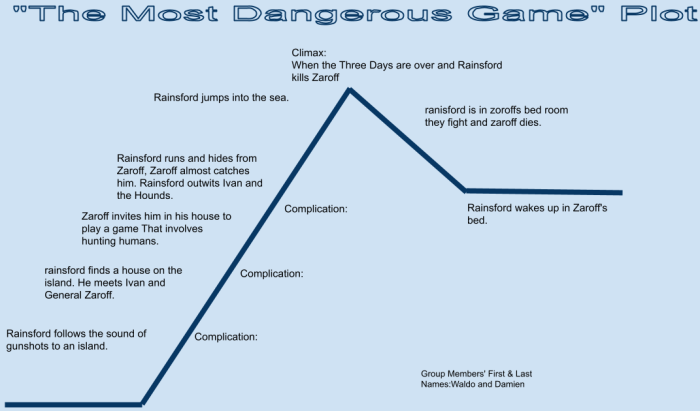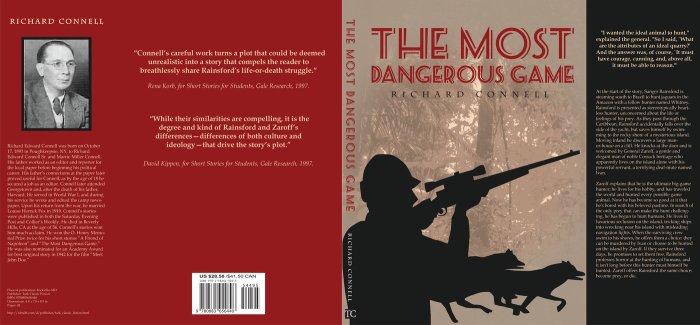Unveiling the intricacies of Richard Connell’s gripping masterpiece, “The Most Dangerous Game,” we embark on a literary expedition that delves into the depths of human nature, survival, and the fragility of civilization. As we uncover the most dangerous game book answers, we will navigate the treacherous terrain of a remote island, unravel the motivations of enigmatic characters, and grapple with profound themes that resonate beyond the pages.
Prepare to be captivated as we dissect the intricate plot, analyze the masterful use of language, and uncover the symbolism that weaves through every layer of this timeless tale. Join us on this literary adventure as we explore the most dangerous game book answers and unlock the secrets that lie within.
Introduction

The Most Dangerous Game, a thrilling short story by Richard Connell, explores the dark depths of human nature and the fragility of civilization. The central theme of the story revolves around the dangers of hubris and the consequences of hunting humans for sport.
Character Analysis
Sanger Rainsford
Sanger Rainsford, the protagonist, is a renowned hunter who believes in the superiority of man over nature. However, his encounter with General Zaroff transforms him, exposing the savagery lurking within him. As the hunted becomes the hunter, Rainsford’s transformation reveals the thin line between civilization and barbarism.
General Zaroff
General Zaroff, the antagonist, is a Russian aristocrat and avid hunter who has grown weary of hunting animals. He believes that humans are the most dangerous game and has created a private island where he hunts them for sport. Zaroff’s motivations stem from his boredom and his belief in the superiority of the hunter over the hunted.
Supporting Characters
Whitney is Rainsford’s hunting companion who initially dismisses Rainsford’s concerns about Zaroff. His role in the story is to provide a contrast to Rainsford’s transformation and to highlight the dangers of complacency.
Setting and Atmosphere
Isolated Island Setting
The story takes place on an isolated island, creating a sense of claustrophobia and isolation. The island’s dense jungle and treacherous terrain become a microcosm of the larger world, where the dangers of nature and the savagery of man are amplified.
Foreshadowing and Suspense
The author skillfully uses foreshadowing and suspense to create a sense of danger and urgency. Rainsford’s initial encounter with Zaroff’s Cossack servant hints at the sinister nature of the island, while the description of the hunting dogs and the island’s eerie silence build tension.
Symbolism of the Island
The island can be seen as a symbol of the larger world, where the struggle for survival and the dangers of hubris are ever-present. The island’s isolation represents the isolation of the individual in the face of nature and the potential for darkness within.
Plot Development, The most dangerous game book answers
Major Events
The story follows a series of key events: Rainsford’s shipwreck, his encounter with Zaroff, his transformation into a hunter, and his final confrontation with Zaroff. These events build suspense and drive the plot towards its climax.
Pacing and Engagement
The story’s pacing is deliberate and engaging, building tension as Rainsford’s situation becomes more desperate. The author uses short chapters and vivid descriptions to create a sense of urgency and keep the reader on the edge of their seat.
Climax and Resolution
The climax of the story occurs when Rainsford and Zaroff engage in a final confrontation. The resolution of the story is both satisfying and thought-provoking, as Rainsford emerges victorious but haunted by his experience.
Themes and Symbolism
Nature of Good and Evil
The story explores the nature of good and evil, blurring the lines between the two. Rainsford’s transformation from a civilized hunter to a savage killer challenges traditional notions of morality and raises questions about the darkness that can reside within.
Dangers of Hubris
The story warns against the dangers of hubris, or excessive pride. Zaroff’s belief in his superiority over others leads to his downfall, as he underestimates Rainsford’s resilience and determination.
Fragility of Civilization
The story highlights the fragility of civilization and the ease with which it can collapse into barbarism. The island setting, isolated from society, becomes a microcosm where the rules of civilization no longer apply.
Style and Language
Language and Imagery
Connell’s use of language is vivid and evocative, creating a sense of atmosphere and suspense. The use of sensory details, such as the sound of the dogs and the smell of the jungle, immerses the reader in the story’s setting.
Figurative Language
The author employs various forms of figurative language, including similes, metaphors, and personification. These literary devices enhance the story’s imagery and convey the characters’ emotions and motivations.
Comparison to Other Works
The Most Dangerous Game can be compared to other works of fiction in the adventure genre, such as The Call of the Wild by Jack London and The Jungle Book by Rudyard Kipling. However, Connell’s story stands out for its exploration of the darker side of human nature and its cautionary tale about the dangers of hubris.
Query Resolution: The Most Dangerous Game Book Answers
What is the central conflict in “The Most Dangerous Game”?
The central conflict revolves around the clash between Sanger Rainsford’s belief in the sanctity of human life and General Zaroff’s twisted view of hunting humans as the ultimate sport.
How does the setting contribute to the atmosphere of suspense in the story?
The isolated island setting, with its dense jungle and treacherous terrain, creates a sense of claustrophobia and vulnerability, heightening the tension and suspense as Rainsford is hunted by Zaroff.
What is the significance of the symbolism of the “game”?
The “game” symbolizes the breakdown of civilization and the primal instincts that can emerge when humans are stripped of their societal constraints. It also represents Zaroff’s twisted desire for power and control.

